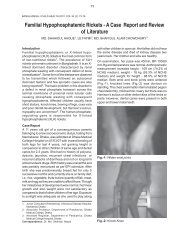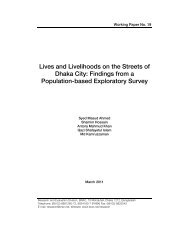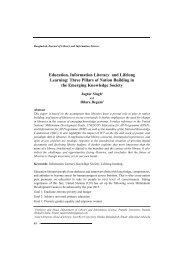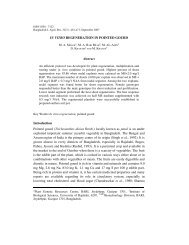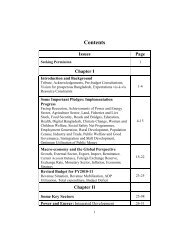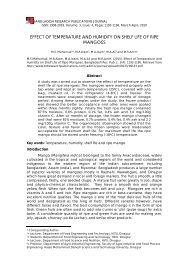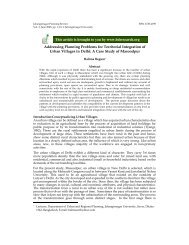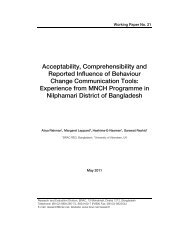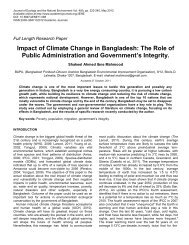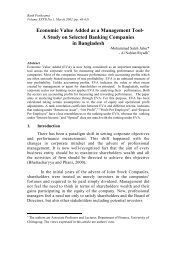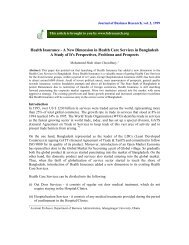8. CONCLUSIONSThe seed supply scenario as investigated in the present study <strong>for</strong> cereal crop producti<strong>on</strong> inBangladesh gives us three c<strong>on</strong>trasting pictures. For wheat seed, where <strong>on</strong>ly the OpenPollinated (OP) varieties are prevailing in the country, 50 -60% of the required seed aresupplied by the farmers` own source as their homegrown seeds, which are actually the ‘seed’saved from their commercial cultivati<strong>on</strong>. The rest of wheat seed are supplied from the public<strong>and</strong> private seed sectors such as Foundati<strong>on</strong> <strong>Seed</strong>, Certified <strong>Seed</strong> or TLS. On the other h<strong>and</strong>,the rice crops comprise both hybrid <strong>and</strong> OP seeds <strong>and</strong> the hybrid rice covers <strong>on</strong>ly about 3% ofthe area, the seeds of which are entirely coming from public <strong>and</strong> private sectors includingseveral seed companies. Of the OP rice seeds, 70-80% of the seed supplies are mitigated fromfarmers’ homegrown seed that is coming from general cultivati<strong>on</strong>. As maize cultivati<strong>on</strong> hascurrently switched over to hybrid varieties, almost cent percent of the maize seed are comingfrom the out-suppliers (private <strong>and</strong> public sectors) <strong>and</strong> most of the maize seeds are ofexogenous origin. There<strong>for</strong>e, the major porti<strong>on</strong> of the seed of rice <strong>and</strong> wheat that is comingfrom farmers’ own supply is not superior in quality in terms of genetic, physical <strong>and</strong>physiological quality, which is c<strong>on</strong>firmed by the present study. But since the private <strong>and</strong> publicsectors in the country are not well organized in terms of infrastructure <strong>and</strong> organizati<strong>on</strong>al setupto supply <strong>and</strong> meet up the large volume of seed required <strong>for</strong> the whole producti<strong>on</strong> system,the present system of farmers’ homegrown seed should be allowed to c<strong>on</strong>tinue. The <strong>on</strong>ly thingthat could be d<strong>on</strong>e is to improve the farmers’ homegrown seed in whatever way it is possible.Thus, a few steps may be suggested towards improvement of seed quality of farmers’homegrown seeds during the producti<strong>on</strong>, processing <strong>and</strong> storage phases so that the farmers’seed quality status of may be improved or assured as far as practicable. The present studygenerates a number of key findings followed by necessary policy recommendati<strong>on</strong>s towardsquality improvement <strong>for</strong> seed producti<strong>on</strong> at farmers’ level.110
ACKNOWLEDGEMENTSAll praises are due to Almighty Allah, who enabled the author to complete the project activities rightly,<strong>and</strong> to prepare & submit this report to the FAO Representati<strong>on</strong> in Bangladesh.The financial grant received from the Nati<strong>on</strong>al Food <strong>Policy</strong> Capacity Strengthening Programme(<strong>NFPCSP</strong>) as aided by the support of EU, USAID, FAO <strong>and</strong> Bangladesh Government is gratefullyacknowledged, because without this fund allocati<strong>on</strong> it would not be possible to c<strong>on</strong>duct this piece ofresearch work. Sincere thanks <strong>and</strong> appreciati<strong>on</strong> are, there<strong>for</strong>e, extended to Mr. Ad Spijkers, FAORepresentative in Bangladesh <strong>and</strong> Mr. Firollo Ciro, Chief Technical Advisor, CFPCSP <strong>for</strong> theirgenerous cooperati<strong>on</strong> in carrying out this study.The FAO members of Bangladesh strictly m<strong>on</strong>itored the research activities from the beginning to theend of the project period. As Technical Assistance Team Members (TAT), Dr. Natalie Bouche(Ec<strong>on</strong>omist) <strong>and</strong> Professor Dr. Shaikh Abdus Sabur are greatly acknowledged <strong>for</strong> m<strong>on</strong>itoring <strong>and</strong>executi<strong>on</strong> of the programme. Dr. Lalita Bhattacharjee (Nutriti<strong>on</strong>ist) later joined the team when Dr.Bouche left Bangladesh <strong>and</strong> special thanks <strong>and</strong> gratefulness are extended to Dr. Battacharjee <strong>for</strong> hertechnical suggesti<strong>on</strong>s as offered in the review meetings as well as <strong>for</strong> her comments made <strong>on</strong> the DraftReport.Professor Dr. Rezaul Karim Talukder (Physical <strong>and</strong> Social Advisor), who took keen interest <strong>on</strong> thetheme of the project <strong>on</strong> seed quality study, is gratefully remembered <strong>for</strong> his c<strong>on</strong>structive criticismspassed in the review meetings.Very special thanks <strong>and</strong> appreciati<strong>on</strong> are given to Dr. Nur Ahmed Kh<strong>on</strong>daker, Research GrantAdministrator, <strong>NFPCSP</strong> <strong>for</strong> his nice commitment to keep research work <strong>on</strong> track by serving numerousmessages from time to time <strong>and</strong> technical advice as well.The project was implemented with the active collaborati<strong>on</strong> of the Department of Agr<strong>on</strong>omy,Bangladesh Agricultural University, Mymensingh. Heartiest thanks are due to Professor Dr.Muhammad Abdus Samamad, Head of the Department of Agr<strong>on</strong>omy, <strong>for</strong> his kind cooperati<strong>on</strong>.Appreciati<strong>on</strong> is given to the teachers of the Department of Agr<strong>on</strong>omy, who were frequently c<strong>on</strong>sulted<strong>for</strong> fulfilling the research objectives of the project <strong>and</strong> worth menti<strong>on</strong>ing of them are: Professor Dr.Masood Ahmed, Professor Dr. Md. Sultan Uddin Bhuiya <strong>and</strong> Professor Dr. Md. Abdur Rahman Sarkar.It would be worth to menti<strong>on</strong> the encouragement <strong>and</strong> technical incentive received from the Vice-Chancellor of Bangladesh Agricultural University, Mymensingh while c<strong>on</strong>ducting the research <strong>and</strong> inparticular of his highlighting the importance of the work <strong>on</strong> seed quality during the project completi<strong>on</strong>workshop held at Bangladesh Agricultural University.Dr. Najrul IslamProfessor, Department of Agr<strong>on</strong>omyBangladesh Agricultural University, MymensinghAnd111



